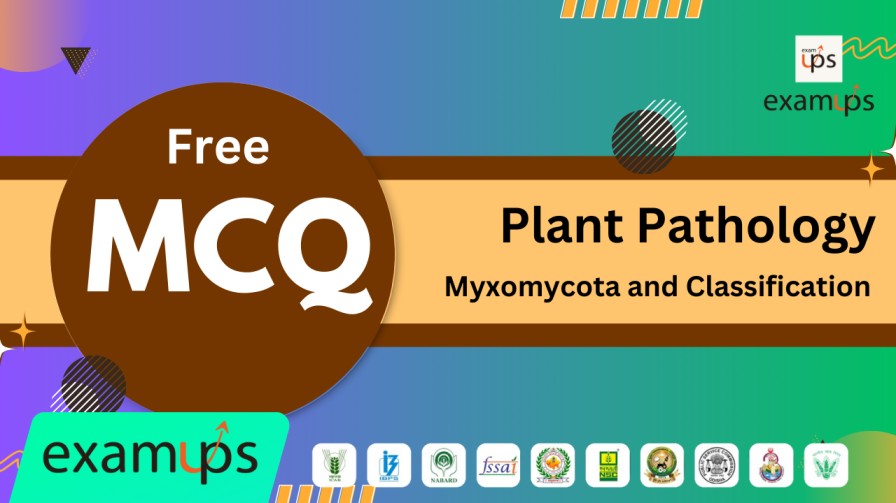MCQs on Myxomycota and Classification
- Which division is characterized by the presence of plasmodium or pseudoplasmodium?
a) Eumycota
b) Myxomycota
c) Basidiomycota
d) Ascomycota
Answer: b - The assimilative phase in Eumycota is:
a) Amoeboid
b) Filamentous
c) Plasmodium-like
d) Spore-producing
Answer: b - The systematic position of Plasmodiophora brassicae places it in which class?
a) Mastigomycotina
b) Plasmodiophoromycetes
c) Basidiomycotina
d) Deuteromycotina
Answer: b - Which family does Plasmodiophora brassicae belong to?
a) Plasmodiophoraceae
b) Uredinales
c) Pucciniaceae
d) Zygomycetes
Answer: a - The disease “club root of cabbage” is caused by:
a) Plasmodiophora brassicae
b) Spongospora subterranea
c) Polymyxa graminis
d) Ustilago maydis
Answer: a
MCQs on Symptoms and Pathogen
- Club-shaped roots in cabbage result from:
a) Hypertrophy and hyperplasia
b) Wilting and yellowing
c) Necrosis of the roots
d) Fungal invasion of leaves
Answer: a - What type of movement is exhibited by the thallus of Plasmodiophora brassicae?
a) Gliding
b) Amoeboid
c) Rotational
d) Flagellar
Answer: b - The resting spores of Plasmodiophora brassicae have:
a) Smooth walls
b) Spiny walls
c) Multinucleate contents
d) None of the above
Answer: b - Zoospores produced by Plasmodiophora brassicae are:
a) Posteriorly biflagellate
b) Anteriorly biflagellate
c) Uniflagellate
d) Non-flagellated
Answer: b - The type of flagella in Plasmodiophora brassicae zoospores is:
a) Whiplash type
b) Tinsel type
c) Both tinsel and whiplash
d) None of the above
Answer: a
MCQs on Life Cycle of Plasmodiophora brassicae
- Infection of root hairs by Plasmodiophora brassicae typically occurs during:
a) Germination stage
b) Seedling stage
c) Flowering stage
d) Maturity stage
Answer: b - Resting spores of Plasmodiophora brassicae can lie dormant in soil for:
a) Several days
b) Several months
c) Several years
d) Forever
Answer: c - What is formed when a resting spore germinates?
a) A zoosporangium
b) A zoospore
c) A zygospore
d) A primary plasmodium
Answer: b - Each resting spore of Plasmodiophora brassicae produces:
a) Multiple zoospores
b) A single zoospore
c) A single hypha
d) None of the above
Answer: b - The zoospore of Plasmodiophora brassicae is:
a) Uninucleate
b) Multinucleate
c) Non-nucleated
d) Binucleate
Answer: a
MCQs on Host Interaction
- The zoospore penetrates:
a) Leaf epidermis
b) Root hairs
c) Stem tissues
d) Seeds
Answer: b - After penetrating the host, the zoospore develops into a:
a) Resting spore
b) Zygospore
c) Primary plasmodium
d) Zoosporangium
Answer: c - The primary plasmodium cleaves into:
a) Zoospores
b) Zygotes
c) Multinucleate portions
d) Resting spores
Answer: c - What is produced inside the zoosporangium?
a) Hyphae
b) Resting spores
c) Zoospores
d) Zygotes
Answer: c - Zoospores are discharged from the host through:
a) Wounds
b) Pores dissolved in the host cell wall
c) Direct penetration
d) Spore-producing hyphae
Answer: b
MCQs on Pathogen Spread
- Zoospores fuse in pairs to produce:
a) Resting spores
b) Zygotes
c) New zoosporangia
d) Plasmodia
Answer: b - The zygotes of Plasmodiophora brassicae have:
a) Two flagella
b) Four flagella
c) No flagella
d) Multiple flagella
Answer: b - The secondary plasmodium spreads to the cortical cells of the host via:
a) Hyphae
b) Direct penetration
c) Zoosporangia
d) Wounds
Answer: b - What happens when the plasmodium establishes in the host cells?
a) The cells die immediately
b) The cells shrink
c) The cells enlarge and divide abnormally
d) The cells form spores
Answer: c - Hypertrophy refers to:
a) Increased cell size
b) Increased cell division
c) Decreased cell division
d) Decreased cell size
Answer: a
MCQs on Club Root Disease and Impact
- Hyperplasia refers to:
a) Increased cell size
b) Increased cell number
c) Decreased cell number
d) Decreased cell size
Answer: b - The club-shaped roots in infected plants are caused by:
a) Cell necrosis
b) Hypertrophy and hyperplasia
c) Mycelium overgrowth
d) Zoospore infection
Answer: b - Stunting, yellowing, and wilting in plants are symptoms of:
a) Myxomycota infection
b) Club root disease
c) Fungal rusts
d) Leaf blight
Answer: b - Resting spores are vital for:
a) Spreading the disease to new hosts
b) Long-term survival of the pathogen
c) Immediate infection of the host
d) Zoospore reproduction
Answer: b - What is the primary role of zoospores in the life cycle of Plasmodiophora brassicae?
a) Dormancy
b) Host infection
c) Reproduction within the soil
d) Formation of resting spores
Answer: b











